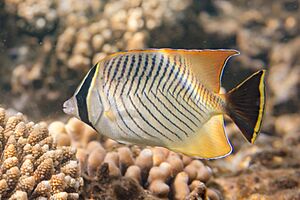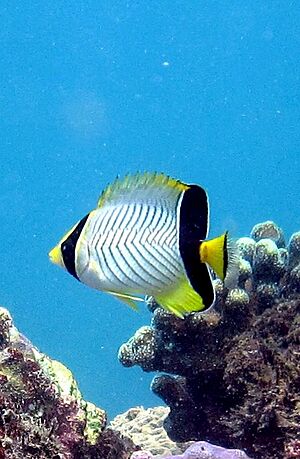Chevron butterflyfish facts for kids
Quick facts for kids Chevron butterflyfish |
|
|---|---|
 |
|
| Adult | |
| Conservation status | |
| Scientific classification | |
| Genus: |
Chaetodon
|
| Species: |
trifascialis
|
| Synonyms | |
|
|
The chevron butterflyfish (Chaetodon trifascialis) is a cool type of fish that lives in the ocean. People also call it the chevroned butterflyfish, triangulate butterflyfish, or V-lined butterflyfish. It's part of the butterflyfish family, which scientists call Chaetodontidae.
You can find these fish in a huge area called the Indo-Pacific. This includes parts of the Indian Ocean and the Pacific Ocean.
It's easy to mix up the chevron butterflyfish with other similar-sounding fish. For example, it's different from the melon butterflyfish (Chaetodon trifasciatus). It's also not the same as the three-striped butterflyfish (Chaetodon tricinctus) or the three-banded butterflyfish (Chaetodon robustus).
Contents
What Does It Look Like?
The chevron butterflyfish has a light-colored body. It's shaped a bit long and thin. You'll see dark, V-shaped lines going up and down its body. These lines look like chevrons.
Its tail is black with a bright yellow edge. There's also a black stripe that goes right through its eye. This stripe has light edges.
Young Fish Look Different
Baby chevron butterflyfish, called juveniles, look a bit different. They have a black stripe that goes from their back fin, across their body, to their bottom fins. Their tail base and side fins are yellow.
This fish can grow up to about 18 centimeters (7 inches) long. Its top fin has 13 to 15 strong spines and 14 to 16 soft rays. The bottom fin has 3 to 5 spines and 13 to 15 soft rays.
Where Do They Live?
The chevron butterflyfish lives in a very large area. This area stretches across the Indo-Pacific.
Indian Ocean Homes
In the western Indian Ocean, you can find them along the coast of East Africa. They live from Egypt all the way down to South Africa. They are also found around islands in the Indian Ocean.
Pacific Ocean Homes
Moving into the Pacific Ocean, they live near the Line Islands and Johnston Atoll. You can also find them around the Howland and Baker Islands. They go as far north as southern Japan. To the south, they reach Lord Howe Island and Rapa Iti.
Australian Waters
In Australia, these fish are found in many places. They live from the Houtman Abrolhos to Beagle Reef. You can also spot them at the Rowley Shoals and Scott Reef in Western Australia. They are common in the northern Great Barrier Reef off Queensland. Some live on reefs in the Coral Sea. They can even be found as far south as Arrawarra Headland in New South Wales. They also live around Australia's Indian Ocean islands, like the Cocos (Keeling) Islands and Christmas Islands.
Life in the Ocean
The chevron butterflyfish likes to have its own space. It's a territorial fish. They live in shallow lagoons and reefs that are somewhat protected from strong currents.
What They Eat
These fish are very closely linked to certain types of coral. They especially like flat, table-shaped corals and branching staghorn corals (Acropora). They eat the soft parts, called polyps, and the slimy mucus that corals produce.
Where They Swim
You can find them swimming at depths from about 2 to 30 meters (6 to 100 feet). Adult fish usually swim alone. But during the time they lay eggs, you might see them in pairs. Young fish are shy and often hide among the coral branches.
How They Reproduce
Chevron butterflyfish are oviparous. This means the females lay eggs, and the babies hatch from these eggs outside the mother's body.
How Scientists Classify Them
Scientists first officially described the chevron butterflyfish in 1825. Two French naturalists, Jean René Constant Quoy and Joseph Paul Gaimard, did this. They found the first one in Guam.
This fish has some special features. Its colors change as it gets older, and it has a unique long shape. Because of this, scientists put it in its own special group called Megaprotodon.
Its closest relatives seem to be other butterflyfish. These include the eightband butterflyfish (C. octofasciatus) and the mirror butterflyfish (C. speculum). If scientists ever decide to split up the main Chaetodon group, Megaprotodon might become its own genus name.



